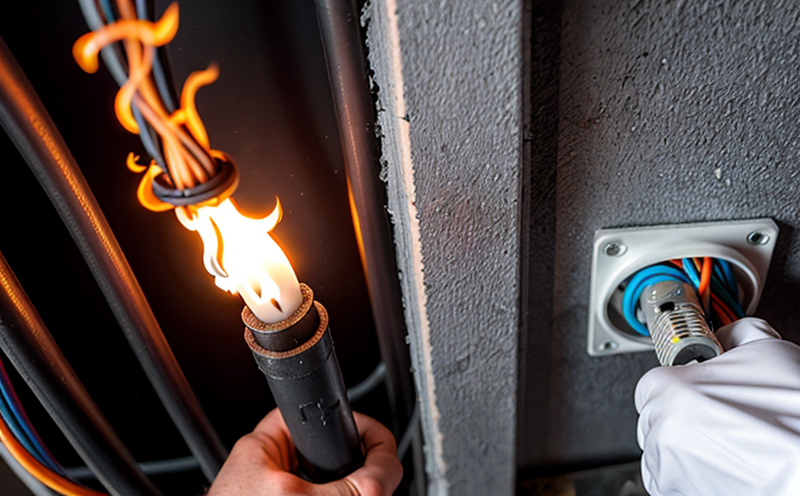Fire Resistance Testing of Industrial Cables
The fire resistance testing of industrial cables is a critical process ensuring that electrical installations remain safe and reliable in the event of a fire. This service involves subjecting industrial cables to controlled fire exposures, assessing their performance under specified conditions, and verifying compliance with relevant standards such as IEC 60332-1, ISO 7859, and ASTM E1354.
Industrial cables are exposed to various environments where they may be subjected to intense heat and flame. Ensuring that these cables can withstand fire without compromising safety is essential for maintaining continuity of operations in industrial settings like manufacturing plants, power generation facilities, and transportation networks. The testing process helps identify potential weaknesses in cable design or material composition which could lead to failures during a fire.
The first step involves selecting the appropriate test method based on the intended use and performance requirements of the cables being tested. For instance, IEC 60332-1 specifies different tests for solid-core and stranded conductors depending on their size and application. After choosing the correct protocol, samples are prepared according to standard procedures before undergoing exposure to a flame source.
During testing, the cable is placed within an apparatus designed specifically for this purpose – typically a furnace or chamber that maintains specific temperatures over time. Observations made during observation periods include monitoring changes in insulation integrity, sheath behavior, and overall structural stability of the sample throughout its duration in the fire environment.
The primary outcome from such testing includes pass/fail results indicating whether the tested cable meets specified criteria outlined by applicable regulations or client expectations regarding flame propagation resistance. Additionally, detailed reports are generated documenting all aspects observed during each trial run including any deviations noted compared to expected outcomes.
These tests play a crucial role in safeguarding lives and property by preventing catastrophic failures due to overheating or melting of essential components under extreme conditions. By ensuring that industrial cables meet stringent quality control measures, this testing service contributes significantly towards enhancing fire safety across various sectors including construction, manufacturing, mining, transportation among others.
Applied Standards
When conducting fire resistance tests on industrial cables, adherence to internationally recognized standards ensures consistency and reliability in results. IEC 60332-1 is one of the most commonly referenced documents specifying methods for determining whether solid-core or stranded conductors can pass through a flame without sustaining significant damage.
- IEC 60332-1: This standard defines four different types of tests (A, B, C, and D) based on varying levels of insulation thickness and conductor size. Each type has specific conditions regarding temperature rise, duration, and other factors to simulate real-world scenarios more accurately.
- ISO 7859: Similar to IEC 60332-1 but provides additional guidance for testing cable assemblies rather than just individual wires or conductors. It focuses on aspects like flame spread rate over time as well as smoke production.
- ASTM E1354: This American Society for Testing Materials standard covers the performance of cross-linked polyethylene (XLPE) insulated power cables in fire conditions. It includes both horizontal and vertical burn tests along with evaluation criteria related to thermal stability.
Adhering strictly to these standards guarantees that the testing results are comparable across different laboratories worldwide, thereby providing confidence among stakeholders about the quality of the products being evaluated.
Customer Impact and Satisfaction
The impact of thorough fire resistance testing extends beyond mere compliance; it directly influences the safety and longevity of industrial installations. By identifying vulnerabilities early on, clients benefit from informed decision-making processes that prioritize product improvement over costly recalls later down the line.
- Enhanced Safety: Ensuring that critical components like cables perform reliably under severe circumstances reduces risks associated with potential failures during fires or other emergencies.
- Increased Efficiency: Reliable products lead to fewer disruptions in operations, minimizing downtime and maintaining productivity levels.
- Better Reputation: Demonstrating commitment to high-quality standards builds trust among end-users and regulatory bodies alike fostering long-term relationships.
At our laboratory, we strive to exceed expectations by delivering precise, accurate results supported by robust documentation. Our dedicated team works closely with clients throughout the entire process from initial consultation through final reporting ensuring complete transparency at every stage of engagement.
Use Cases and Application Examples
The application examples of fire resistance testing in industrial cables are numerous and varied across different industries:
- Manufacturing Facilities: Ensures continuous production even during unexpected power outages due to fires.
- Mining Operations: Protects miners from hazardous conditions caused by electrical shorts or overheating within tunnels.
- Petrochemical Plants: Prevents explosions and containment breaches resulting in massive property damage.
- Transportation Networks: Guarantees safe travel for passengers and goods through reliable infrastructure during emergency situations.
In each case, robust fire resistance testing plays a vital role in safeguarding human life while minimizing economic losses. The expertise of our team ensures that every aspect of your project receives the attention it deserves from initial planning stages right up until completion.





